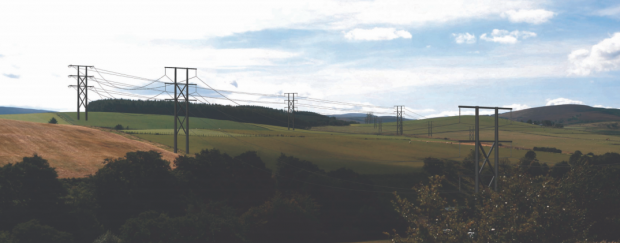Controversial plans to erect giant pylons to hook up a windfarm took another twist yesterday – when councillors had their objections silenced by planning rules.
Scottish Hydro Electric Transmission want to erect 78ft electric poles across the countryside to hook the 59-turbine Dorenell windfarm to the National Grid.
The cables will stretch for over 14 miles from the Dorenell turbines to the Blackhillock substation near Keith.
But Dufftown residents have united to fight the proposals, amid concerns they will spoil the landscape.
Yesterday, councillors were asked for their views on the plans, which will eventually be determined by the Scottish Government.
They also raised fears that the project could blight the landscape for decades – with senior councillor Allan Wright urging members of the planning and regulatory services committee to come out against the plans as not enough had been done to explore other options.
He said: “Developers always say undergrounding is so much more expensive than alternatives, but I have yet to see any estimates compared to having 135 of these pylons – that’s a lot.
“I would rather have the exact figures in front of me when making my decision, whether it’s two or three times more expensive or only 25%. I don’t know but I would like to know.”
Mr Wright added: “With overground cables the impact is there for 25 years. If it’s underground then it’s done and dusted and that’s an end to it.”
Buckie councillor Gordon McDonald joined the call to object to the power line while asking for more details about the cost of underground alternatives.
But legal officer Aileen Scott urged committee members to back away from an objection based on alternatives amid suggestions an inquiry could be triggered.
Chairman Chris Tuke repeatedly stated the cost of a development was not a planning concern.
Mrs Scott said: “You may have another prefer another option, but that isn’t what you are being asked to consider.”
Councillors were split during the lengthy discussions, with Speyside Glenlivet member Mike McConnachie backing the development and arguing underground cables could also harm the environment.
He said: “In an ideal world undergrounding would be the solution. Roads would have to be built though with hundreds of tonnes of rock being put down. That would be a scar on the landscape that would remain there.”
Committee members called for more time for information to be prepared but were told by planners a decision was needed at the end of the meeting.
Eventually a neutral stand point was agreed, neither supporting or opposing the plans while raising concerns about the lack of time to submit a response.
And last night leading protester Colin Mackenzie, who lives near Dufftown less than a mile from where the poles will be built, hailed the neutral stance as the best outcome.
He said: “Hopefully this will place some doubt in the mind of the Scottish Government when they’re looking at it. The case has been made for undergrounding and I don’t know why they won’t look at it.”
Last week, fears were raised by Marine Scotland that clearing land for the poles, which will be dropped into place by helicopter, could harm fish.
A SHE Transmission spokesman said the firm was committed to reduce visual impacts from the project while finding the most “economical solution”.
He said: “Following detailed consultation and site investigations the preferred option, based on technical efficiency, cost and environmental impacts, is to provide the connection to the between the wind farm and Blackhillock substation via twin composite poles running in parallel, which resemble wood poles.”
